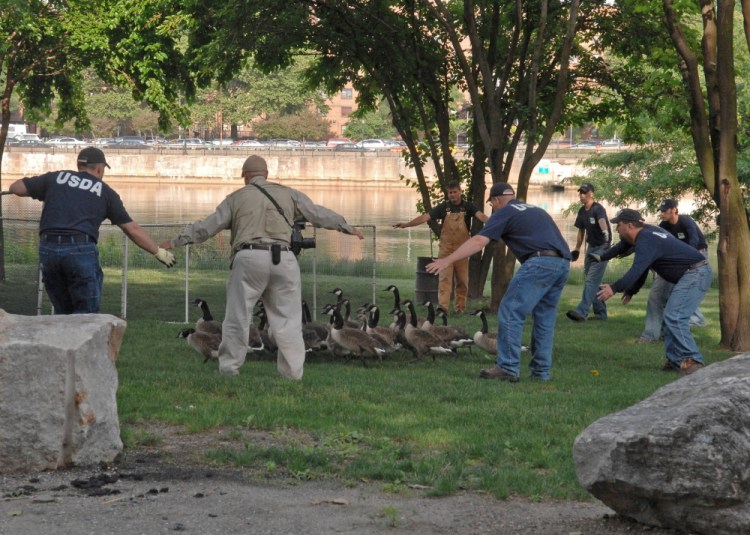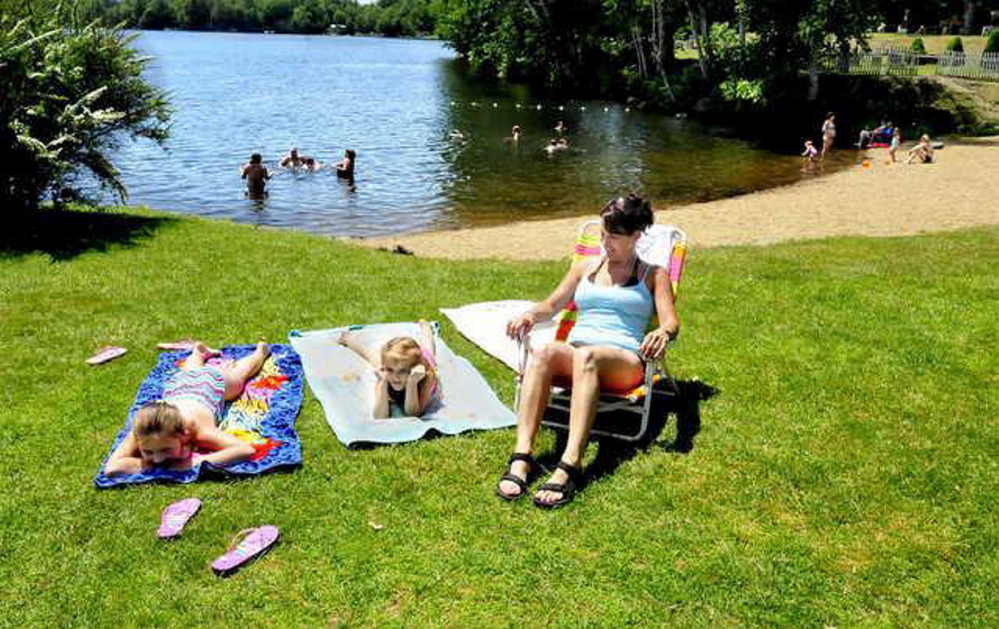Federal and state officials in Maine are defending their decision to capture and kill 18 Canada geese that had been drawing complaints at a beach in Oakland.
On June 20, the town of Oakland hired the state wildlife services office of the United States Department of Agriculture to remove the geese from a swimming area on Messalonskee Lake. Town officials say they intended for the geese to be relocated to another area, but instead the geese were euthanized after a state wildlife biologist said area waterways already had too many geese to safely release more.
Robin Dyer, state director of the USDA’s Wildlife Services department, said in a statement Friday that her staff made it clear to Oakland workers that the geese would not be relocated and characterized the situation as a “misunderstanding.”
In her letter, Dyer said, “I am confident that my staff was clear in explaining to town staff that no sites were available for relocating the geese at this time, although I cannot speak to how the misunderstanding with town officials occurred.”
When the fate of the geese was reported in the Morning Sentinel and other media outlets, it created a public backlash from animal lovers who said they were angry at the decision to kill the geese, which included at least two sets of parents and several goslings.
Oakland Town Manager Peter Nielsen and Town Council member Mark Fisher both said that town staff did not know the geese would be killed, and Fisher accused the USDA of misleading the town. Town officials said that if they had known the geese would be killed, they would not have hired the service.
Keel Kemper, a wildlife biologist with the Maine Department of Inland Fisheries and Wildlife, said he did not make the call to kill the geese, but said he supports the decision.
“I wouldn’t disagree with the end result,” he said. “It may sound hard, but there are just times when we have to use lethal removal.”
Kemper said he suspected the root cause of the turmoil in the Oakland case was poor communication between the town and the USDA, which seemed to be on different pages about what would happen to the geese.
Wildlife control officers are often caught between a rock and a hard place because public opinion can be sharply divided on killing animals that are causing problems for their human neighbors.
“You’re kind of stuck in the middle of it,” he said. “Half the people are unhappy with it, and the other half are psyched.”
RELOCATION QUESTION
The question as to whether the geese could have been successfully relocated is still unanswered. Kemper said that, in his experience, relocating geese simply does not work.
“If you take these birds and you take them off to Flagstaff Lake, they’re back before you’re back,” he said.
Nielsen said the USDA workers told him and other Oakland staff that the geese could be relocated at this time of year because they were molting and had just had young and so were unlikely to fly long distances to return to the beach.
Even then, Kemper said, the chance of long-term success is low.
“They’ll molt and then they’ll fly right back,” he said. “They’re honed in on those locations and they know a good food source.”
Dyer initially said the geese could not be released because the birds are overpopulated in the region.
In a letter released Friday, she expanded on the point.
“We have received complaints about damage caused by geese in new locations after we have relocated geese,” she wrote. “After conferring with State wildlife management personnel, we were informed that sites were unavailable for relocation this year.”
Fisher said that the USDA was simply not looking hard enough.
“There are 2,200 lakes in the state of Maine,” he said. “I live on a lake myself with no geese on it.”
Many members of the public questioned whether the geese had to be removed from the Oakland beach at all.
In Dyer’s letter, she wrote that geese produce more fecal matter than one might think — as much as a pound per bird, per day.
“In simple terms, most people prefer not to walk, play or eat in areas covered with feces and would not let their children do these things,” she said.
She also expanded on her previous statement that releasing geese into waterways can cause human health concerns because of fecal matter in the water, a claim that seemed to be at odds with a 2005 state report on the birds that said “Canada goose feces pose relatively little risk to human health.”
In her letter, Dyer said emerging research shows that there are health risks in goose feces, including the presence of E. coli bacteria.
“It was found to be more common in warm months and among resident Canada Geese,” she wrote. “Recent studies have found that 95 percent of a disease-causing bacteria called fecal coliform found in urban watersheds comes from animals.”
While the science on the dangers of goose feces is not yet definitive, it is clear that the fecal matter generates complaints and has the power to render some public places unusable for many people.
“This time of year,” Kemper said, “we receive goose complaints almost on a daily basis from landowners that have the same exact concerns that the town of Oakland does.”
Dyer said that her department’s record in using nonlethal means to remove geese in response to such complaints was clear.
“From 2009-2013, Wildlife Services in Maine relocated more than 200 Canada geese, chased away more than 2,000 and lethally removed fewer than 100,” she wrote.
Dyer acknowledged that lethal removal is categorically opposed by a significant segment of the public.
“We understand that many people object to the use of lethal control,” she wrote. “As a certified wildlife biologist, I agree with other wildlife management professionals that removal of the animals causing damage can be an essential and responsible part of wildlife management.”
TOO MANY GEESE?
Kemper said that there are both too many and too few Canada geese in the state of Maine.
“You really have two populations of geese in Maine. You have what I call resident golf course geese. They’re generally here year-round,” he said. “These are the ones that have created the nuisance. Their population has exploded.”
Those geese are larger than the migratory populations that serve as sport for hunters, Kemper, the state biologist, said.
In her letter, Dyer wrote that the resident goose population increased nationally from 230,000 to 3.89 million birds between 1970 and 2009, and while she called it a “conservation success story,” Dyer said it has led to increased conflict between people and geese.
“Then you have what I call, for lack of a better word, real geese,” Kemper said. “They migrate up to the tundra, have their babies. These are the ones we see in the V formations in the sky.”
The U.S. Fish and Wildlife Service regulates a September hunt of the birds during which 4,700 birds were shot in 2010 alone, Dyer pointed out.
Kemper said that migratory goose populations are in a downward decline even as the resident geese are becoming more of a problem and prompting more complaints.
“There’s no doubt the resident population has exploded onto the landscape.”
Kemper said that wildlife biologists take on that career in order to save animals, not kill them.
“None of us like to go to lethal removal,” he said. “It’s never a first-choice option.”
But sometimes, he said, using lethal means to resolve complaints becomes the only option remaining on the table.
“We believe that the citizens of the state of Maine expect a better response than, ‘There was a problem so I killed it.’ And that’s a reasonable expectation,” he said.
Kemper said that, while nuisance geese must ultimately be addressed, he and other wildlife officials always recommend using nonlethal means first, which can involve changing the landscape or engaging in a campaign of harassment to convince the geese to move to more peaceful waters.
“You want to be able to say, ‘I tried that and it didn’t work. I used dogs, I used whizzbangers, noise and decoys, all these deterrents, and they didn’t work.'”
In Oakland’s case, town workers had tried a variety of methods advised by the USDA. Plantings designed to make the place less inviting were trampled by beachgoers, a harassment campaign failed to deter the geese and an effort to find and neutralize the eggs of the goose nests was unsuccessful.
Dyer wrote that the USDA had assisted Oakland with such efforts for more than four years.
For other landowners plagued by unwanted geese, Kemper said there is often a simple solution that doesn’t cost a dime.
“The most effective thing I’ve found no one wants to do, which is alter the habitat,” Kemper said. “As long as you’re mowing that grass, you’re creating an all-you-can-eat salad bar.”
He said that homeowners would be better served to cultivate a shaggier lawn that doesn’t appeal to the birds.
“If you let that grass grow to four or eight inches, particularly if it’s difficult for them to waddle through, so the grass sticks to their breast feathers, they’ll go away,” he said.
Matt Hongoltz-Hetling — 861-9287
Twitter: @hh_matt
Send questions/comments to the editors.




Success. Please wait for the page to reload. If the page does not reload within 5 seconds, please refresh the page.
Enter your email and password to access comments.
Hi, to comment on stories you must . This profile is in addition to your subscription and website login.
Already have a commenting profile? .
Invalid username/password.
Please check your email to confirm and complete your registration.
Only subscribers are eligible to post comments. Please subscribe or login first for digital access. Here’s why.
Use the form below to reset your password. When you've submitted your account email, we will send an email with a reset code.